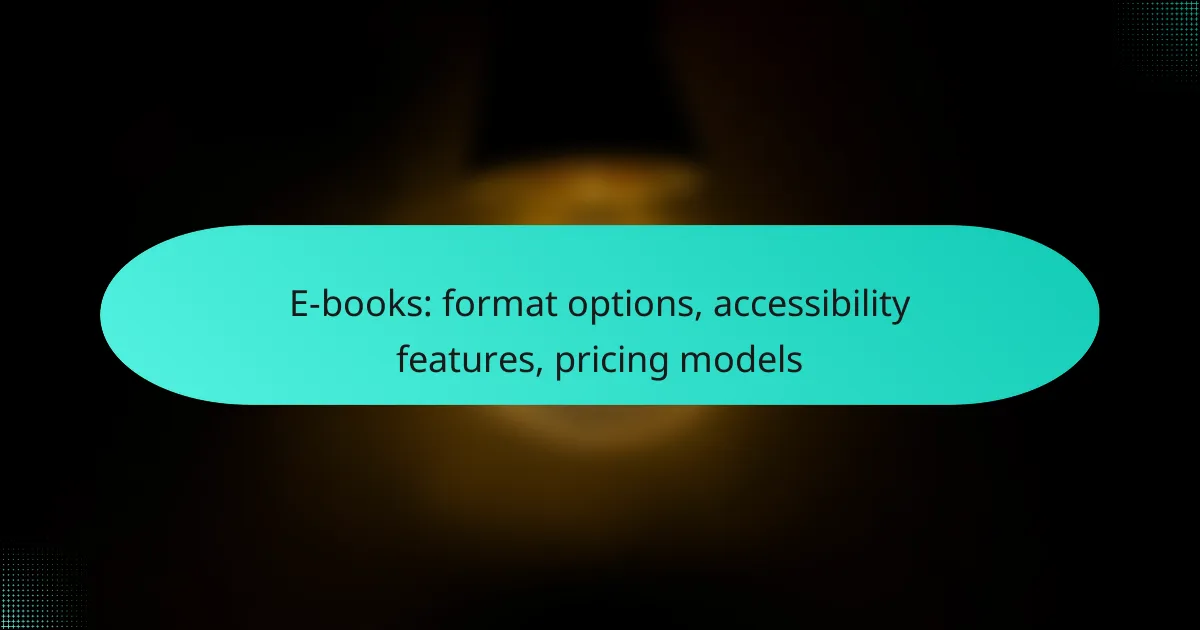E-books offer a variety of formats such as EPUB, MOBI, and PDF, each designed to enhance the reading experience while considering compatibility across devices. Accessibility features are crucial for making e-books usable for individuals with disabilities, ensuring that everyone can enjoy the content. Additionally, diverse pricing models, including subscriptions and one-time purchases, cater to different consumer preferences and publisher strategies.
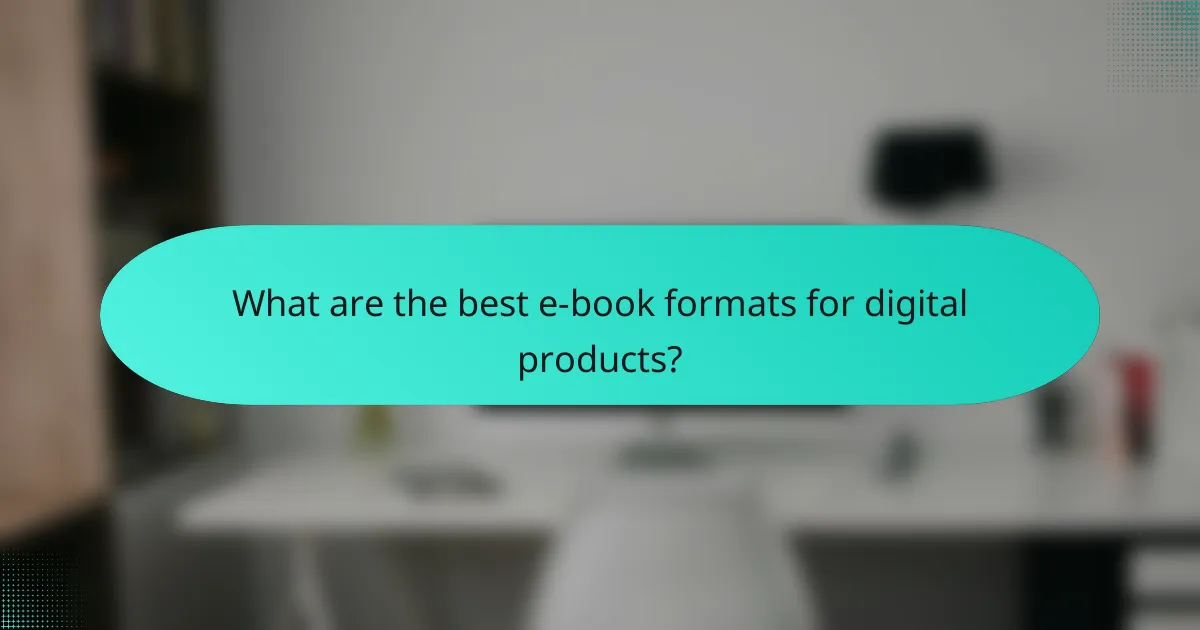
What are the best e-book formats for digital products?
The best e-book formats for digital products include EPUB, MOBI, PDF, KFX, and AZW. Each format has unique features and compatibility considerations that can affect how readers access and experience e-books.
EPUB format
EPUB is a widely used e-book format that supports reflowable content, making it adaptable to various screen sizes. It is compatible with most e-readers, including Apple Books and Kobo devices, but not with Amazon Kindle without conversion.
When creating an EPUB, ensure that it adheres to the latest EPUB standards for better accessibility and features. This format allows for embedded multimedia and interactive elements, enhancing reader engagement.
MOBI format
MOBI is primarily associated with Amazon Kindle devices and apps. This format supports features like bookmarks and annotations but has limitations in terms of multimedia content compared to EPUB.
For authors targeting Kindle users, MOBI is essential. However, it’s important to note that MOBI files can be converted to other formats if needed, but some formatting may be lost in the process.
PDF format
PDF is a fixed-layout format that preserves the original design of documents, making it ideal for e-books that require specific formatting, such as textbooks or manuals. However, it is less flexible on smaller screens.
While PDFs can be read on virtually any device, they do not support reflowable text, which can hinder readability on e-readers. Consider using PDFs for content that must maintain its layout, but be cautious of user experience on mobile devices.
KFX format
KFX is a newer format used by Amazon for Kindle e-books, offering enhanced features like improved typography and layout options. It is designed to provide a better reading experience on Kindle devices.
However, KFX is not widely supported outside of Amazon’s ecosystem, limiting its use for authors and publishers who want broader distribution. If targeting Kindle users, consider KFX for its advanced capabilities, but be aware of its compatibility restrictions.
AZW format
AZW is another format used by Amazon for Kindle e-books, similar to MOBI but with additional DRM (Digital Rights Management) features. This format is optimized for Kindle devices and supports a variety of interactive features.
When publishing e-books for the Kindle platform, AZW is a suitable choice, especially if you want to implement DRM to protect your content. Keep in mind that AZW files are not easily convertible to other formats, which can limit distribution options.
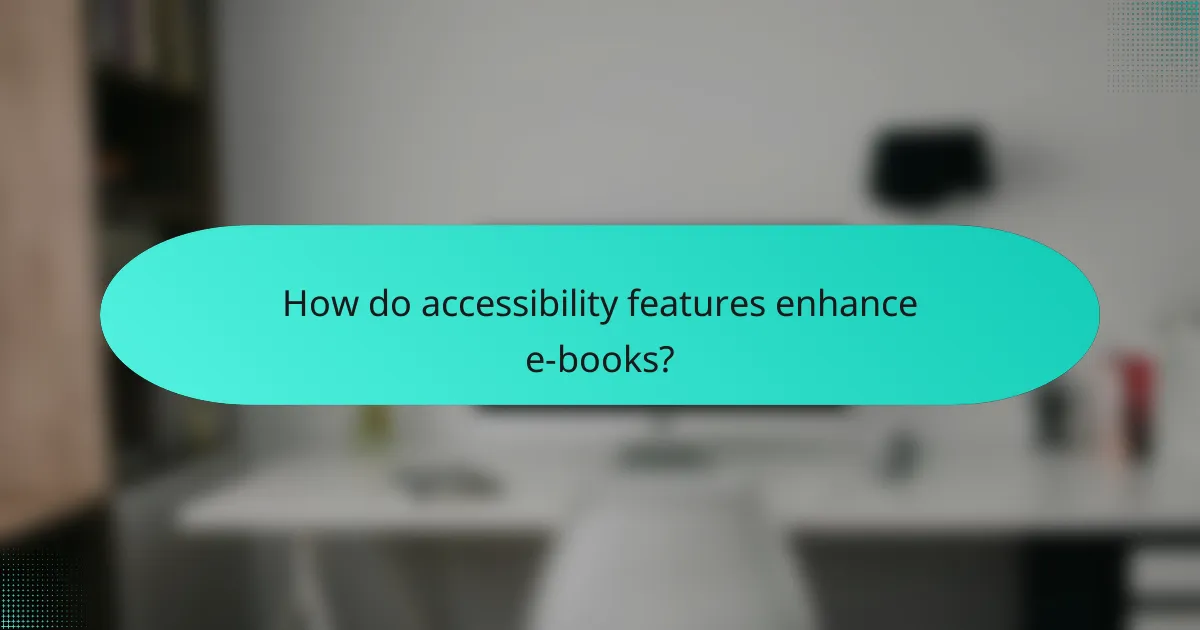
How do accessibility features enhance e-books?
Accessibility features significantly improve the usability of e-books for individuals with disabilities, allowing them to engage with content more effectively. These features cater to various needs, ensuring that everyone can enjoy reading regardless of their physical or cognitive limitations.
Text-to-speech functionality
Text-to-speech functionality converts written text into spoken words, enabling users to listen to e-books instead of reading them. This feature is particularly beneficial for individuals with visual impairments or reading disabilities, as it allows them to access content audibly. Many e-book platforms offer customizable voice options and playback speeds to enhance the listening experience.
Adjustable font sizes
Adjustable font sizes allow readers to modify text size according to their visual comfort, which is crucial for those with low vision. Users can typically increase or decrease font sizes easily within the e-book settings. This flexibility helps reduce eye strain and improves readability, making the content more accessible to a wider audience.
Screen reader compatibility
Screen reader compatibility ensures that e-books can be read aloud by software designed for visually impaired users. E-books that follow accessibility guidelines, such as the EPUB Accessibility 1.0 specification, are more likely to work seamlessly with popular screen readers. This compatibility allows users to navigate through the text, headings, and other elements effectively.
Alternative text for images
Alternative text for images provides descriptive text that conveys the content and purpose of visuals within e-books. This feature is essential for users who cannot see images, as it allows them to understand the context and significance of visual elements. Authors and publishers should ensure that all images include meaningful alt text to enhance the reading experience for everyone.

What are the pricing models for e-books?
E-book pricing models vary widely, catering to different consumer preferences and publisher strategies. The most common models include subscription-based pricing, one-time purchases, freemium options, and pay-per-download systems.
Subscription-based pricing
Subscription-based pricing allows readers to access a library of e-books for a recurring fee, typically charged monthly or annually. This model is popular among platforms like Kindle Unlimited or Scribd, where users can read multiple titles without purchasing each one individually.
Consider the trade-off between cost and selection; while subscriptions can be economical for avid readers, they may not be worth it for those who read infrequently. Always check the catalog to ensure it includes your preferred genres or authors.
One-time purchase model
The one-time purchase model requires readers to buy e-books individually, providing permanent access to the titles. Prices can range from a few dollars for older titles to higher amounts for new releases or bestsellers.
This model is straightforward and allows readers to own their books outright. However, it can become costly for those who read extensively, so it’s wise to look for discounts or bundles that offer savings on multiple purchases.
Freemium model
In the freemium model, e-books are offered for free with the option to purchase additional content or features. This approach is often used by authors or publishers to attract readers and build a following.
While the initial access is free, be cautious of hidden costs associated with premium content. This model can be beneficial for exploring new authors or genres without financial commitment, but always read the fine print regarding what is included for free.
Pay-per-download model
The pay-per-download model charges readers for each e-book downloaded, similar to purchasing a physical book. This model is commonly used by independent authors and smaller publishers who may not have the resources for subscription services.
While this model allows for flexibility in purchasing, it can lead to higher overall costs for frequent readers. Look for promotional offers or discounts to make the most of this pricing structure, especially during sales events or holidays.
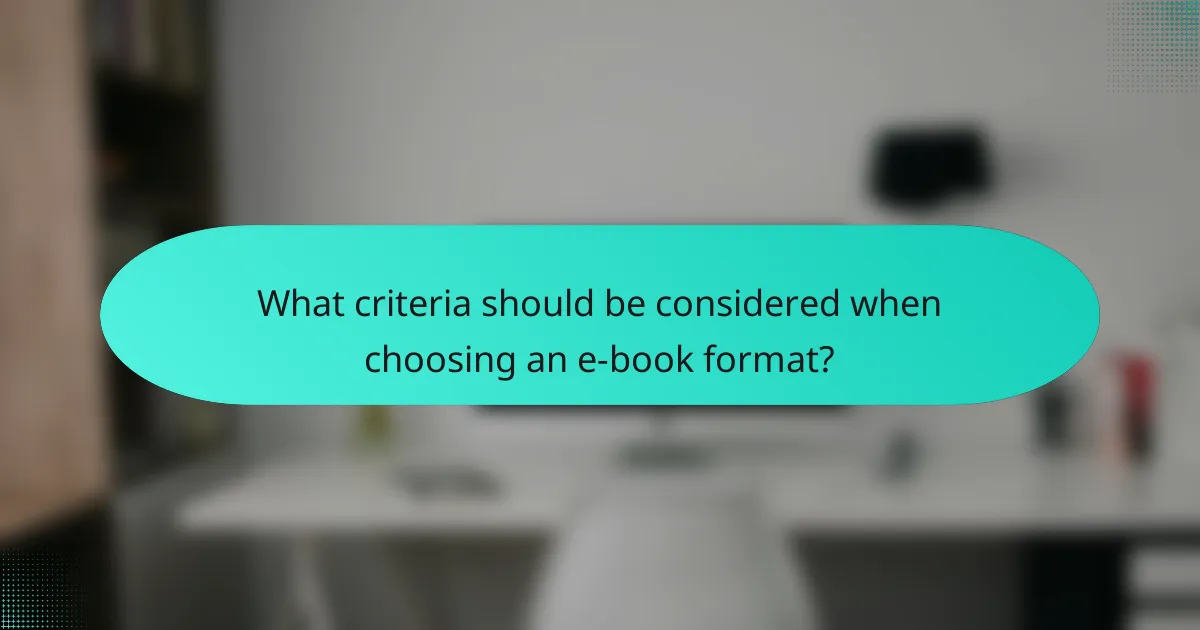
What criteria should be considered when choosing an e-book format?
When selecting an e-book format, consider factors such as device compatibility, user experience, and distribution channels. Each of these criteria affects how readers access and interact with your content.
Device compatibility
Device compatibility is crucial because different formats work on various e-readers, tablets, and smartphones. Popular formats include EPUB, MOBI, and PDF, each with unique strengths and limitations. For instance, EPUB is widely supported on most devices, while MOBI is primarily used on Amazon Kindle.
Before finalizing a format, check which devices your target audience uses. This ensures that your e-book is accessible to as many readers as possible, enhancing its reach and potential sales.
User experience
User experience encompasses how easily readers can navigate, read, and interact with your e-book. Formats like EPUB allow for reflowable text, which adjusts to different screen sizes, improving readability. In contrast, PDF maintains a fixed layout, which may not be as user-friendly on smaller screens.
Consider incorporating features such as adjustable font sizes, bookmarks, and interactive elements to enhance the reading experience. A positive user experience can lead to higher engagement and better reviews.
Distribution channels
Distribution channels determine how and where your e-book will be sold or shared. Different formats may be required for various platforms; for example, Amazon Kindle Direct Publishing accepts MOBI, while Apple Books prefers EPUB. Understanding these requirements can streamline the publishing process.
Evaluate your marketing strategy and choose formats that align with your distribution goals. If you plan to sell directly from your website, consider offering multiple formats to cater to different preferences, maximizing your audience reach.
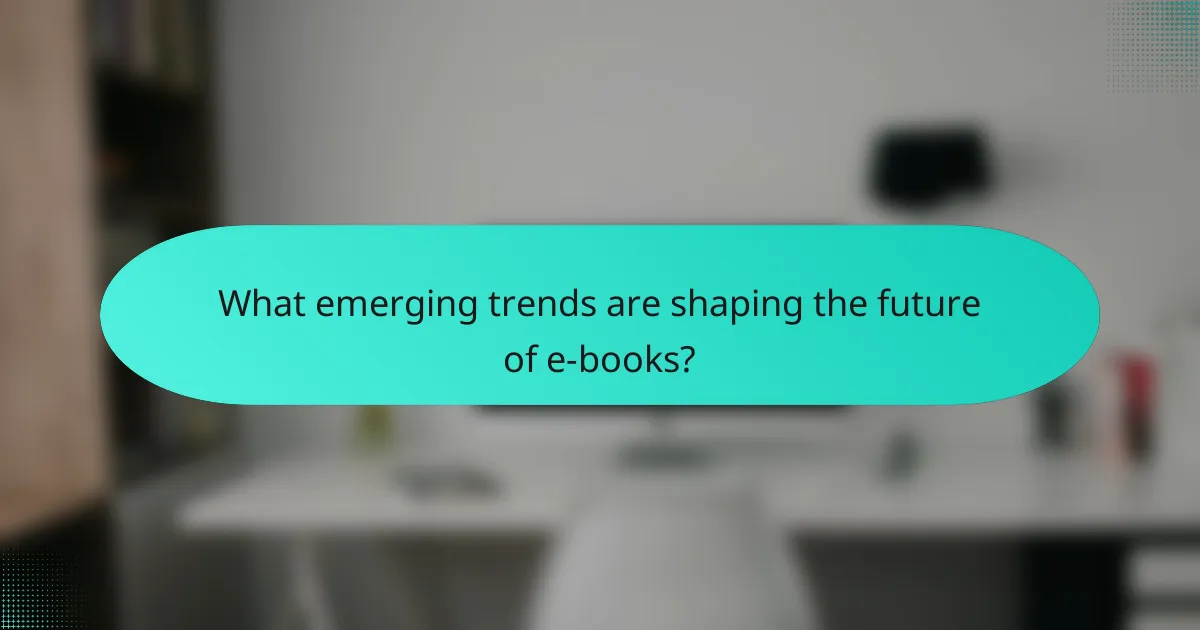
What emerging trends are shaping the future of e-books?
Emerging trends in e-books are significantly transforming how readers interact with digital content. Key developments include the integration of augmented reality, enhanced accessibility features, and innovative pricing models that cater to diverse audiences.
Integration of augmented reality
Augmented reality (AR) is increasingly being integrated into e-books, providing readers with immersive experiences that blend digital content with the real world. This technology allows for interactive elements such as 3D models, animations, and contextual information that enhance the storytelling process.
For example, an educational e-book on biology might include AR features that allow students to visualize complex structures like DNA strands or cellular processes in real-time. This interactivity can improve comprehension and retention, making learning more engaging.
When considering AR for e-books, it’s essential to ensure that the technology is user-friendly and accessible across various devices. Readers should have a seamless experience, whether they are using a smartphone, tablet, or AR glasses. Publishers should also be mindful of the additional costs associated with developing AR content, which can vary widely based on complexity.
